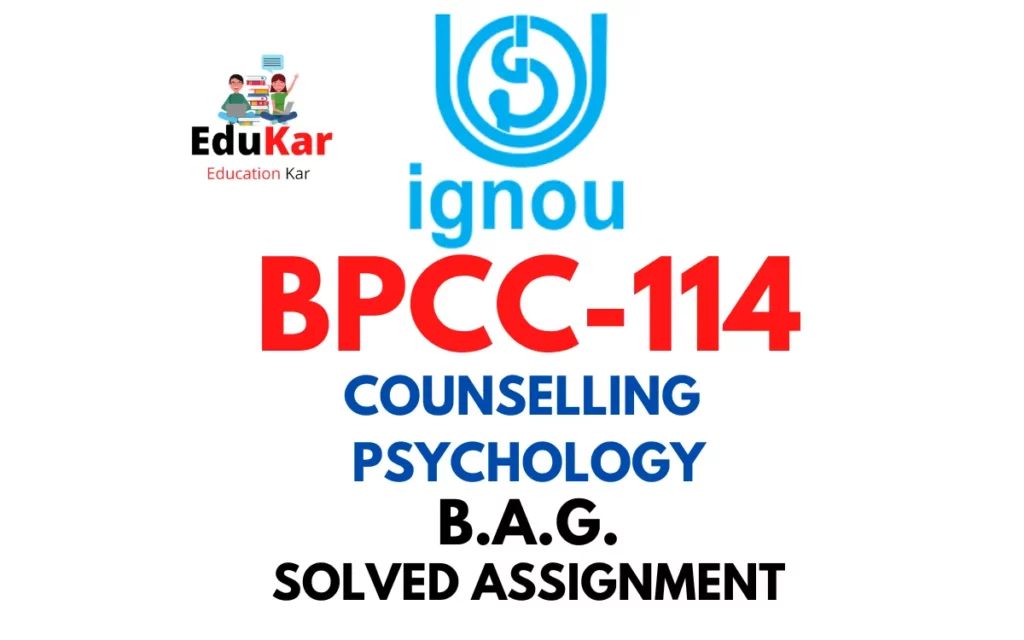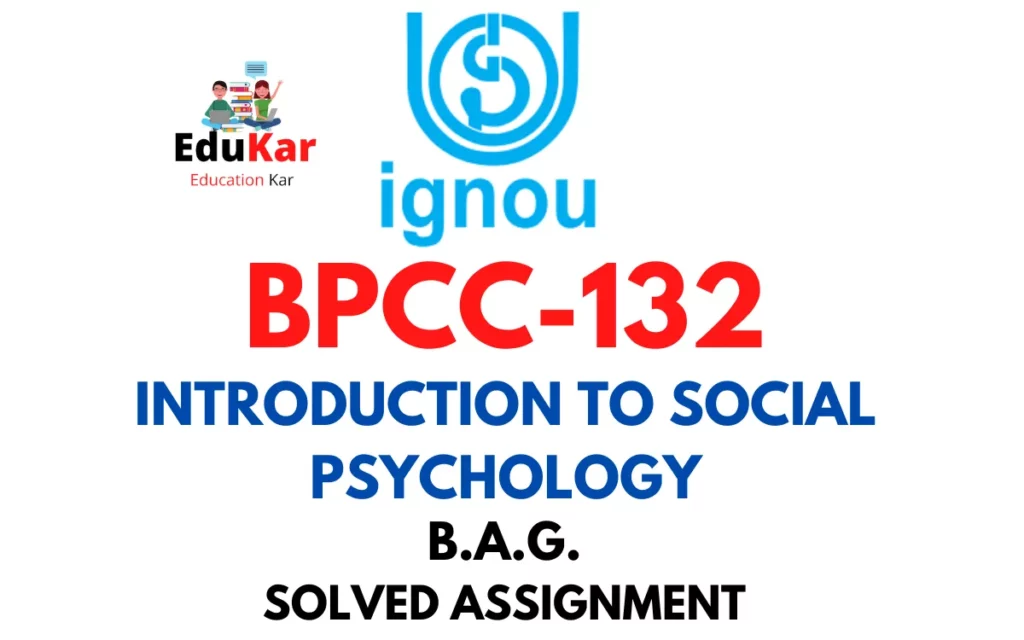Contents
- 1 Assignment One
- 2 Answer the following descriptive category questions in about 500 words each.
- 3 1. Discuss the nature and characteristics of emotions. Differentiate it from mood and feelings.
- 4 2. Explain the meaning and importance of self-regard. Describe the strategies to develop self-regard.
- 5 3. Elaborate on the relationship between emotions and assertiveness. How can assertiveness be developed?
- 6 Assignment Two
- 7 Answer the following short category questions in about 100 words each.
- 8 4. Explain the types of emotions.
- 9 5. Discuss the relationship between emotion, thinking and behavior.
- 10 6. Define emotional intelligence.
- 11 7. Explain the sub-components of social awareness.
- 12 8. Discuss the strategies to develop self-actualization.
- 13 9. How can one develop self-control?
- 14 10. Briefly explain the five emotional competencies given by Goleman.
- 15 11. Explain the relationship between IQ and EQ.
BPCS 185 Solved Assignment 2022-2023: This post is designed to provide students with a comprehensive and in-depth understanding of the course content. This assignment is designed to help students apply the concepts and theories learned in the course to real-world situations. The solved assignments are created by experienced professionals and are reviewed by subject matter experts to ensure their accuracy and quality. The solutions provided in this assignment are easy to understand, well-explained, and concise, making it an excellent resource for students who want to excel in their studies.
| Title | BPCS 185-DEVELOPING EMOTIONAL COMPETENCE (IGNOU-BAG) Solved Assignment 2022-2023 |
| University | IGNOU |
| Degree | Bachelor Degree Programme |
| Course Code | BPCS 185 |
| Course Name | DEVELOPING EMOTIONAL COMPETENCE |
| Total Marks | 100 |
| Year | 2023 |
| Language | English |
| Assignment Code | BANS 183/ASST/TMA |
| Last Date for Submission of Assignment: | For June Examination: 31st March For December Examination: 30th September |
Assignment One
Answer the following descriptive category questions in about 500 words each.
1. Discuss the nature and characteristics of emotions. Differentiate it from mood and feelings.
Answer. Emotions are complex psychological states that are driven by an individual’s internal and external stimuli. They are characterized by physiological arousal, expressive behavior, and conscious experience. Emotions can be positive (e.g. happiness, love), negative (e.g. anger, fear), or neutral (e.g. surprise, boredom). They are believed to have evolved to help individuals respond quickly and effectively to important events in their environment.
Mood, on the other hand, refers to a more general and enduring emotional state that lasts for an extended period of time. Moods are less intense and less specific than emotions and often lack a clear trigger. They can be positive (e.g. happiness, contentment), negative (e.g. depression, anxiety), or neutral (e.g. calm, boredom). Moods tend to color an individual’s perception of events and influence their overall outlook on life.
Feelings, in comparison, are the subjective experience of emotions. They refer to the personal interpretation of an emotion and how it is experienced by the individual. Feelings can vary greatly between individuals, even in response to the same emotional stimulus.
In summary, emotions are short-lived, intense, and specific responses to events, moods are more long-lasting and general emotional states, and feelings are the subjective experience of emotions.
In conclusion, emotions, moods, and feelings are closely related concepts that contribute to an individual’s overall emotional well-being. Understanding the nature and characteristics of these psychological states can provide insight into why individuals respond to events the way they do and help individuals better manage their emotions.
2. Explain the meaning and importance of self-regard. Describe the strategies to develop self-regard.
Answer. Self-regard refers to an individual’s overall evaluation of themselves and their self-worth. It encompasses one’s beliefs, attitudes, and opinions about their own abilities, traits, and accomplishments. High self-regard means that an individual has a positive view of themselves, while low self-regard can lead to feelings of inferiority, self-doubt, and low self-esteem.
The importance of self-regard lies in its impact on an individual’s mental health and overall well-being. Individuals with high self-regard tend to have a more positive outlook on life, greater resilience in the face of challenges, and higher levels of self-confidence and self-efficacy. On the other hand, low self-regard can lead to negative consequences such as anxiety, depression, and a lack of motivation.
Developing self-regard requires a combination of self-reflection and positive self-talk. Some strategies to develop self-regard include:
- Practice self-compassion: Treat yourself with kindness, understanding, and compassion, just as you would treat a friend.
- Focus on your strengths and accomplishments: Take the time to reflect on your strengths and accomplishments and give yourself credit for them.
- Surround yourself with positive people: Seek out supportive and encouraging people who will lift you up and help you develop a more positive self-image.
- Set realistic goals: Setting achievable goals and celebrating your successes can help boost your self-esteem and self-regard.
- Engage in activities that make you feel good: Engage in activities that bring you joy and fulfillment and that help you develop a positive self-image.
- Avoid self-criticism: Instead of criticizing yourself, focus on your positive qualities and traits.
- Learn to say “no”: Learning to set boundaries and say “no” to people and situations that are harmful or draining can help boost your self-regard.
In conclusion, self-regard is a critical aspect of an individual’s overall well-being and mental health. By focusing on self-compassion, goal setting, and positive self-talk, individuals can develop a positive self-image and increase their self-regard. By doing so, individuals can experience greater self-confidence, resilience, and overall happiness.
3. Elaborate on the relationship between emotions and assertiveness. How can assertiveness be developed?
Answer. Emotions and assertiveness are closely related as emotions often drive assertiveness behavior. Assertiveness refers to the ability to clearly express one’s thoughts, feelings, and needs in a confident and direct manner, without violating the rights of others.
Emotions can either facilitate or hinder assertiveness. Positive emotions such as confidence and self-assuredness can increase an individual’s assertiveness, while negative emotions such as anxiety and fear can decrease it.
Assertiveness is important as it helps individuals to effectively communicate their needs, opinions, and boundaries. It can also lead to greater self-esteem, improved relationships, and reduced stress.
Developing assertiveness can be challenging, but it is a crucial life skill that can be learned and improved upon with practice. Some strategies to develop assertiveness include:
- Communicate clearly and directly: Speak up and express your thoughts, feelings, and needs clearly and directly.
- Practice active listening: Listen attentively to others and ask questions to ensure you understand their perspectives.
- Set clear boundaries: Know your limits and be clear about what you are and are not willing to do.
- Build self-confidence: Engage in activities that help you build self-confidence and self-esteem.
- Accept accountability for your deeds: Recognize your errors and accept accountability for your deeds.
- Be assertive in non-threatening situations: Practice assertiveness in non-threatening situations to build your confidence.
- Use “I” phrases to convey your thoughts and emotions instead of blaming or criticising others.
- Avoid aggressive or passive behavior: Aggressive behavior can harm relationships, while passive behavior can lead to frustration and a lack of control. Instead, aim for assertive behavior that balances your own needs with those of others.
In conclusion, emotions and assertiveness are closely related and can impact each other. Developing assertiveness can help individuals to effectively communicate their needs, improve relationships, and increase self-esteem. By practicing assertiveness and learning to communicate in a clear and direct manner, individuals can become more confident and self-assured.
Assignment Two
Answer the following short category questions in about 100 words each.
4. Explain the types of emotions.
Answer. Emotions are complex, subjective experiences that are influenced by a combination of physical, psychological, and social factors. There are many different kinds of emotions, but few of the most common include:
- Positive emotions: Happiness, excitement, love, and gratitude are examples of positive emotions that bring feelings of joy and pleasure.
- Negative emotions: Anger, fear, sadness, and jealousy are examples of negative emotions that bring feelings of discomfort and pain.
- Mixed emotions: Ambivalence, guilt, and shame are examples of mixed emotions that bring both positive and negative feelings.
- Primary emotions: These are universal emotions that are experienced by people across cultures and are thought to have evolved as survival mechanisms. Examples likes sadness, happiness, anger & fear.
- Secondary emotions: These are emotions that are learned and culturally specific. Examples include embarrassment, guilt, and shame.
- Social emotions: These are emotions that are elicited by social situations and relationships. Examples include embarrassment, guilt, & jealousy.
- Physiological emotions: These are emotions that are associated with physical responses such as increased heart rate, sweating, and blushing. Examples include excitement, fear, and anger.
In conclusion, emotions are complex experiences that come in many different forms. Understanding the different types of emotions and their origins can help individuals better understand their own emotions and those of others.
5. Discuss the relationship between emotion, thinking and behavior.
Answer. Emotion, thinking, and behavior are interconnected and influence each other in complex ways. Emotions are subjective experiences that are influenced by both internal and external factors. They can impact how individuals think and behave, and can be expressed through thoughts, feelings, and actions.
Thinking, in turn, can influence emotions. Negative thoughts can lead to negative emotions, while positive thoughts can lead to positive emotions. Similarly, behavior can also impact emotions. Engaging in activities that bring joy and pleasure can lead to positive emotions, while engaging in activities that bring discomfort and pain can lead to negative emotions.
Behavior can also be influenced by emotions and thoughts. For example, feelings of anxiety may lead to avoidance behavior, while feelings of confidence may lead to assertive behavior. Additionally, behavior can also influence thoughts and emotions. Engaging in new and challenging activities can help individuals to overcome negative thoughts and emotions.
In conclusion, emotion, thinking, and behavior are closely interconnected and influence each other in complex ways. Understanding this relationship can help individuals to better understand their own emotions and behaviors, and to develop strategies to manage them effectively.
6. Define emotional intelligence.
Answer. Emotional intelligence refers to the ability to recognize, understand, and manage one’s own emotions and the emotions of others. It involves the ability to perceive emotions accurately, to use emotions to facilitate thinking, to understand emotional meanings, and to manage emotions in oneself and others. Emotional intelligence is considered a critical component of overall intelligence and is linked to success in many areas of life, including relationships, academic and career performance, and mental and physical health. Developing emotional intelligence can involve improving self-awareness, empathy, and emotional regulation skills, and can lead to greater success and well-being in life.
Answer. Social awareness refers to the ability to understand the emotions, needs, and perspectives of others in social situations. It is a critical component of emotional intelligence and involves several sub-components, including:
- Empathy: the capacity to sympathise with and comprehend the emotions of others.
- Perspective-taking: The ability to understand and consider different perspectives and viewpoints.
- Social cognition: The ability to understand social cues and relationships between people.
- Cultural intelligence: The ability to understand and navigate cultural differences and norms.
- Service orientation: The desire to help others and the ability to identify the needs of others.
Developing these sub-components of social awareness can improve one’s ability to effectively navigate social situations, build better relationships, and be more attuned to the emotions and needs of others. Improving social awareness can also lead to greater success in both personal and professional settings.
8. Discuss the strategies to develop self-actualization.
Answer. Self-actualization refers to the process of realizing one’s full potential and reaching the highest level of personal growth and development. There are several strategies that individuals can use to develop self-actualization, including:
- Setting and pursuing personal goals: Identifying and working towards meaningful and fulfilling goals can help individuals to grow and develop.
- Engaging in personal growth activities: Engaging in activities such as self-reflection, learning new skills, and exploring new interests can help individuals to expand their perspectives and grow as individuals.
- Building supportive relationships: Developing positive and supportive relationships with others can provide a foundation for growth and development.
- Pursuing self-acceptance and self-compassion: Accepting oneself, flaws and all, and treating oneself with kindness and compassion can help individuals to build a strong sense of self-worth and to grow as individuals.
- Cultivating a growth mindset: Adopting a growth mindset, which involves viewing challenges and failures as opportunities for growth, can help individuals to overcome obstacles and continue to grow and develop.
By pursuing these strategies, individuals can work towards self-actualization and reach their full potential.
9. How can one develop self-control?
Answer. Self-control refers to the ability to regulate one’s thoughts, emotions, and behaviors in order to achieve desired goals and outcomes. There are several strategies that individuals can use to develop self-control, including:
- Setting clear goals and boundaries: Identifying specific goals and creating clear boundaries can help individuals to stay focused and avoid distractions.
- Practicing mindfulness: Engaging in mindfulness practices, such as meditation, can help individuals to become more aware of their thoughts and emotions and to regulate them effectively.
- Building self-awareness: Increasing self-awareness through self-reflection and journaling can help individuals to better understand their own thought patterns and emotional triggers.
- Developing healthy habits: Creating healthy habits, such as regular exercise and proper nutrition, can help to increase self-discipline and self-control.
- Fostering self-compassion: Treating oneself with kindness and compassion can help individuals to overcome self-criticism and maintain self-control.
By pursuing these strategies, individuals can develop the self-control skills needed to achieve their desired goals and outcomes.
10. Briefly explain the five emotional competencies given by Goleman.
Answer. The five emotional competencies identified by psychologist Daniel Goleman are:
- Self-awareness: The capacity to perceive and comprehend one’s own emotions, as well as how they affect others.
- Self-regulation: The ability to manage and control one’s own emotions and behaviors.
- Motivation: The ability to use emotions to drive action and pursue goals.
- Empathy: The capacity to identify with and feel other people’s emotions.
- Social skills: The ability to build and maintain positive relationships with others through effective communication and interpersonal skills.
Goleman’s five emotional competencies provide a framework for understanding the skills and abilities necessary for success in personal and professional life. Improving these competencies can help individuals to better manage their emotions, build better relationships, and achieve their desired goals.
11. Explain the relationship between IQ and EQ.
Answer. IQ (Intelligence Quotient) and EQ (Emotional Quotient) are two different measures of cognitive and emotional abilities. While IQ measures a person’s cognitive abilities, including logical reasoning, problem solving, and memory, EQ measures a person’s emotional abilities, including self-awareness, self-regulation, empathy, and social skills.
The relationship between IQ and EQ is complex and multifaceted. While high IQ can be an advantage in some areas, it does not guarantee success in personal or professional life. On the other hand, high EQ can help individuals to better manage their emotions, build strong relationships, and communicate effectively with others, which can be crucial for success in life.
Therefore, both IQ and EQ are important, and a balance of both can lead to greater success in personal and professional life. By developing both cognitive and emotional skills, individuals can be better equipped to navigate the challenges and opportunities of life.
How to Download BPCS 185-DEVELOPING EMOTIONAL COMPETENCE Solved Assignment?
You can download it from the www.edukar.in, they have a big database for all the IGNOU solved assignments.
Is the BPCS 185-DEVELOPING EMOTIONAL COMPETENCE Solved Assignment Free?
Yes this is absolutely free to download the solved assignment from www.edukar.in
What is the last submission date for (IGNOU-BAG) Solved Assignment?
For June Examination: 31st March, For December Examination: 30th September














![[Solved Assignment] BPCS 188-APPLICATIONS OF SOCIAL PSYCHOLOGY (IGNOU-BAG) 2022-2023 BPCS 188-APPLICATIONS OF SOCIAL PSYCHOLOGY IGNOU BAG Solved Assignment 2022-2023](https://edukar.org/wp-content/uploads/2023/01/BPCS-188-APPLICATIONS-OF-SOCIAL-PSYCHOLOGY-IGNOU-BAG-Solved-Assignment-2022-2023-1024x640.webp)